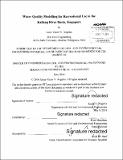Water quality modelling for recreational use in the Kallang River Basin, Singapore
Author(s)
Angeles, Justin Victor V. (Justin Victor Velayo)
DownloadFull printable version (6.724Mb)
Other Contributors
Massachusetts Institute of Technology. Department of Civil and Environmental Engineering.
Advisor
Peter Shanahan.
Terms of use
Metadata
Show full item recordAbstract
Singapore's Active, Beautiful, and Clean Waters Programme (ABC) aims to provide functional use of its water bodies to the public. The Kallang River Basin, being part of the ABC Programme, will be used for recreational purposes such as dragon boating and other water sports. In order to provide safe recreational use for the public, the water quality of the Kallang River Basin needed to be determined and modeled. The water quality indicator chosen to be analyzed was Escherichia coli (E. coli) bacteria. A heuristic study was performed in order to determine the water quality and as well determine if water quality modeling was feasible for the Kallang River Basin. The study employed the United States Environmental Protection Agency WASP (Water Quality Analysis Simulation Program) model. Through WASP model simulations, it was found that certain parts of the Kallang River Basin were not suitable for recreational purposes and others parts were deemed suitable. E. coli concentrations predicted by the model were within the range of actual field data but diurnal variations were not captured by the model for lack of data with which to specify diurnally varying inputs. The WASP model created by this study suggests that water quality modeling for the Kallang River Basin is feasible but there are modifications that need to be made to accurately capture diurnal variations experienced by the Kallang River Basin. Future investigation into the diurnal variations would contribute to creating a more complete and accurate model for the Kallang River Basin.
Description
Thesis: M. Eng., Massachusetts Institute of Technology, Department of Civil and Environmental Engineering, 2014. Cataloged from PDF version of thesis. Includes bibliographical references (pages 42-45).
Date issued
2014Department
Massachusetts Institute of Technology. Department of Civil and Environmental EngineeringPublisher
Massachusetts Institute of Technology
Keywords
Civil and Environmental Engineering.